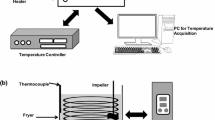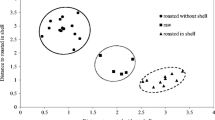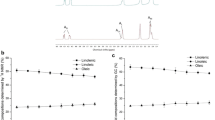Summary
Standard chemical and physical indexes, such as color index, acid value, and K270 were compared with the polar content and the specific thermoxidative and hydrolytic compounds originated during 75 potato fryings with sun-flower oil. The color index, acid value, K270 and total polar content showed a significant increase (p<0.05) after the first 30 fryings, followed by a tendency of the last three indexes to reach a near-steady state. Triglyceride polymers and triglyceride dimers showed a significant increase (p<0.05) after 30 fryings, while the oxidized triglycerides were not increased significantly after 30 fryings. The amount of diglycerides and free fatty acids related to hydrolytic alteration did not change significantly throughout the frying operations. The significant correlations between acid value and total polar content, triglyceride dimers, triglycerides polymers and oxidized triglycerides, or between color index and polar content and triglyceride polymers or between K270 and triglyceride polymers indicate that these simple and standard methods can be applied and they are as useful as more specific methods of evaluation in the monitoring of frying operations, provided that initial values of all of these indexes are available.
Zusammenfassung
Chemische und physikalische Standardkennzahlen, wie zum Beispiel der Refraktions-und Farbindex, die Säurezahl und der K270-Wert, wurden mit den Gehalten an polaren Verbindungen sowie spezifischen thermooxidativen und hydrolytischen Fettbestandteilen verglichen, die in einem Sonnenblumenöl, das 75 mal zum Fritieren von Kartoffeln benutzt worden war, entstanden sind. Der Farbindex, die Säurezahl, der K270-Wert und der Gehalt an polaren Verbindungen stiegen signifikant (p<0,05) nach 30 Fritierungen. Anschließend stabilisierten sich die drei letztgenannten Indices. Der Inhalt an polymeren Verbindungen und Triglyceridendimeren stieg signifikant nach 30 Fritierungen an (p<0,05), während die oxidierten Triglyceride keine signifikante Steigerung aufwiesen. Der Gehalt an Diglyceriden und freien Fettsäuren, als Maß der hydrolytischen Vorgänge, zeigte während des Fritierprozesses keine signifikante Veränderung. Die signifikanten Korrelationen zwischen der Säurezahl und dem Gehalt an polaren Verbindungen, den dimeren und polymeren Triglyceriden und den oxydierten Triglyceriden, zwischen dem Farbindex und dem Gehalt an polaren Verbindungen und polymeren Triglyceriden, oder zwischen dem K270-Wert und den polymeren Triglyceriden zeigen, daß diese einfachen Standard-Methoden benutzt werden können und genauso nützlich sind wie mehr spezifische Methoden zur Bewertung von Fritierprozessen, wenn man die Ausgangswerte aller dieser Indices kennt.
Similar content being viewed by others
References
Arroyo C, Cuesta C, Garrido-Polonio C, López-Varela S, Sánchez-Muniz FJ (1992) J Am Oil Chem Soc 69:557–563
Bacuerlen R, Brody H, Erickson D (1968) Bakers Digest 42:51–59
Bender A (1978) Food Processing and Nutrition. Academic Press, London, pp 82–83
Billek G (1985) Padley FB, Podmore U in collaboration with Brun JP, Burt R and Nicols BW (eds) The Role of Fats in Human Nutrition. Ellis Horwood Ltd, Chichester (England), pp 163–171
Boskou D (1988) Varela G, Bender AE, Morton ID (eds) Frying of Food. Principles, Changes, New Approaches. Ellis Horwood Ltd, Chichester (England), pp 174–182
Blumenthal MM (1991) Food Technol 45:68–71
Christopoulou CN, Perkins EG (1986) J Am Oil Chem Soc 63:679–684
Cuesta C, Sánchez-Muniz FJ, Hernández I, López-Varela S (1991) Rev Agroq Tecnol Aliment 31:523–531
Cuesta C, Sánchez-Muniz FJ, Hernández I (1991) J Am Oil Chem Soc 68:443–445
Cuesta C, Sánchez-Muniz FJ, Garrido-Polonio C, López-Varela S, Arroyo R (1993) J Am Oil Chem Soc 70:1069–1073
Dobarganes MC, Pérez-Camino MC, Márquez-Ruiz G (1988) Fat Sci Technol 90:308–311
Domenech JH (1982) Bioestadística. Métodos estadísticos para investigadores (4th edition). Herder, Barcelona (Spain), pp 337–341
Fritsch CV (1981) J Am Oil Chem Soc 58:272–274
Gere A (1984) Rev Franç Corps Gras 31:437–442
Gere A (1982) Die Nahrung 26:923–932
Gutiérrez González-Quijano R, Dobarganes MC (1988) Varela G, Bender AE, Morton ID (eds) Frying of Food. Principles, Changes, New Approaches. Ellis Horwood Ltd, Chichester (England), pp 141–154
Hara K, Cho SY, Fujimoto K (1989) J Jpn Oil Chem Soc 38:463–470
Kupranycz OB, Amer MA, Baber BE (1986) J Am Oil Chem Soc 63:332–337
Perrin JL, Perfetti C, Dimitriades C, Naudet M (1985) Rev Franç Corps Gras 32:151–158
Prevot A, Desborden S, Morin O, Mordret F (1988) Varela G, Bender AE, Morton ID (eds) Frying of Food. Principles, Changes, New Approaches. Ellis Horwood Ltd, Chichester (England), pp 155–165
Sánchez-Muniz FJ, Cuesta C, Garrido-Polonio MC (1993) J Am Oil Chem Soc 70:235–240
Sánchez-Muniz FJ, Cuesta C, Garrido-Polonio MC (1994) Z Ernährungswiss 33:16–23
Sanelli B (1979) Riv Ital Sostance Grasse 56:223–234
Stevenson SG, Vaisey-Genser M, Eskin NAM (1984) J Am Oil Chem Soc 61:1102–1108
UNE 5501 (1958) Materias grasas. Determinación de ácidos libres. Instituto Nacional de Racionalización y Normalizacion, Madrid
UNE 55-047-73 (1973) Materias grasas. Medida espectrofotométrica de la absorción en la región ultravioleta. Instituto Nacional de Normalización, Madrid
Viola P, Bianchi A (1988) Varela G, Bender AE, Morton ID (eds) Frying of Food. Principles, Changes, New Approaches. Ellis Horwood Ltd, Chichester (England), pp 129–138
Waltking AE, Wessels H (1981) J Assoc Off Chem 64:1329–1330
Wolff JP (1988) Manual d'Analyse des Corps Gras. Asuolay, Paris
Yoon SH, Kim SK, Kwon WT (1987) J Am Oil Chem Soc 64:870–873
Author information
Authors and Affiliations
Rights and permissions
About this article
Cite this article
López-Varela, S., Sánchez-Muniz, F.J., Garrido-Polonio, C. et al. Relationship between chemical and physical indexes and column and HPSE chromatography methods for evaluating frying oil. Z Ernährungswiss 34, 308–313 (1995). https://doi.org/10.1007/BF01625343
Received:
Accepted:
Published:
Issue Date:
DOI: https://doi.org/10.1007/BF01625343




